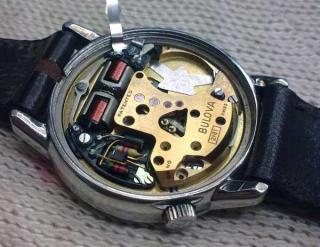ufology
Master Poster
- Joined
- Jun 30, 2011
- Messages
- 2,681
I've been trying to figure out if Hoagland's "inertial field detector" is a gimmick or what, but from what I can tell, there could very well be something to it. This isn't to say that all the Hoagland's hypotheses and theories that have sprung up surrounding it are true, but to start with, this instrument isn't something Hoagland invented. It was invented by physicist Bruce DePalma. But I haven't been able to find anything definitive that explains why it works the way that it does, but it does seem to register changes that manifest themselves as a discrepancy in time between the Accutron and the computer that does the analyzing. It also seems true that when it is placed near spinning masses the readings do change, and it is this phenomenon that has led Hoagland to link it to Torsion Field Theory.
Without going into detail on the various incarnations of Torsion Field Theory ( TFT ), they all seem to referring to the idea that there is a sort of "fabric" to space that is affected by the presence of mass. We sometimes see this idea illustrated ( as an analogy ) by placing a ball on a rubber sheet upon which some kind of grid has been drawn, or by some similar 3D rendering where planets are caught in something that looks like a net, but which is meant to illustrate the bending of space itself. Inertial Field Theory suggests that in the presence of mass, this space grid doesn't simply dent inward but also that when the mass is spinning, it drags space around with it a small amount resulting in a sort of elastic compression of the fabric of space. The compression patterns are sometimes called a "torsion field" and are envisioned as waves or ripples that move out away from the object in a spiral like manner.
This brings me to my question. What makes this device work the way it does? So far I've found no conventional scientific explanation, but if anyone has an explanation, please let me know, and in the meantime I'll keep rummaging around for more information. In the context of Inertial Field Theory, it seems that what's being implied is that changes in the density of space cause changes in the mass ( and consequently the intertia ) of the metal that composes the tuning forks in the Accutron, resulting in a change in the rate of vibration, and in turn the measurement of time. Right now I'm still trying to wrap my head around this concept. Something about it doesn't seem exactly right, but the variables aren't easy for me to visualize because it isn't just mass alone. This hypothetical space density variable should affect not only the mass of the tuning fork, but also its tensile properties. In other words, if the mass becomes denser and therefore heavier and consequently slower to vibrate, should not the density also amplify the tensile properties ( the springiness of the metal ) thereby compensating and resulting in no change? Perhaps the two properties aren't perfectly synchronous with each other. I don't know. If anyone can help me figure this out please post up!
Without going into detail on the various incarnations of Torsion Field Theory ( TFT ), they all seem to referring to the idea that there is a sort of "fabric" to space that is affected by the presence of mass. We sometimes see this idea illustrated ( as an analogy ) by placing a ball on a rubber sheet upon which some kind of grid has been drawn, or by some similar 3D rendering where planets are caught in something that looks like a net, but which is meant to illustrate the bending of space itself. Inertial Field Theory suggests that in the presence of mass, this space grid doesn't simply dent inward but also that when the mass is spinning, it drags space around with it a small amount resulting in a sort of elastic compression of the fabric of space. The compression patterns are sometimes called a "torsion field" and are envisioned as waves or ripples that move out away from the object in a spiral like manner.
This brings me to my question. What makes this device work the way it does? So far I've found no conventional scientific explanation, but if anyone has an explanation, please let me know, and in the meantime I'll keep rummaging around for more information. In the context of Inertial Field Theory, it seems that what's being implied is that changes in the density of space cause changes in the mass ( and consequently the intertia ) of the metal that composes the tuning forks in the Accutron, resulting in a change in the rate of vibration, and in turn the measurement of time. Right now I'm still trying to wrap my head around this concept. Something about it doesn't seem exactly right, but the variables aren't easy for me to visualize because it isn't just mass alone. This hypothetical space density variable should affect not only the mass of the tuning fork, but also its tensile properties. In other words, if the mass becomes denser and therefore heavier and consequently slower to vibrate, should not the density also amplify the tensile properties ( the springiness of the metal ) thereby compensating and resulting in no change? Perhaps the two properties aren't perfectly synchronous with each other. I don't know. If anyone can help me figure this out please post up!


